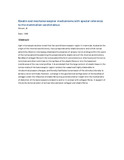| dc.contributor.author | Kimani, JK | |
| dc.date.accessioned | 2013-06-06T08:39:52Z | |
| dc.date.available | 2013-06-06T08:39:52Z | |
| dc.date.issued | 1995 | |
| dc.identifier.citation | Ciba Found Symp. 1995;192:215-30; discussion 230-6. | en |
| dc.identifier.issn | http://hinari-gw.who.int/whalecomwww.ncbi.nlm.nih.gov/whalecom0/pubmed/8575259 | |
| dc.identifier.uri | http://erepository.uonbi.ac.ke:8080/xmlui/handle/123456789/29031 | |
| dc.identifier.uri | http://www.ncbi.nlm.nih.gov/pubmed/8575259 | |
| dc.description.abstract | Light microscopic studies reveal that the carotid baroreceptor region in mammals, located at the origin of the internal carotid artery, has a preponderantly elastic structure and a thick tunica adventitia. Electron microscopy discloses the presence of sensory nerve endings within the parts of the tunica adventitia adjoining the preponderantly elastic zone of the internal carotid artery. Bundles of collagen fibres in the tunica adventitia form convolutions or whorls around the nerve terminals and often terminate on the surface of the elastic fibres or into the basement membranes of the neuronal profiles. It is concluded that the large content of elastic tissue in the tunica media of the baroreceptor region renders the vessel wall highly distensible to intraluminal pressure changes, and thereby facilitates transmission of the stimulus intensity to sensory nerve terminals. However, a change in the geometrical configuration of the bundles of collagen under the influence of elastic fibres may provide a better insight into the mechanisms of distortion of the baroreceptors related to and/or in contact with collagen fibres. In support of this is the demonstration of contact sites between collagen and elastic fibres | en |
| dc.language.iso | en | en |
| dc.title | Elastin and mechanoreceptor mechanisms with special reference to the mammalian carotid sinus | en |
| dc.type | Article | en |
| local.publisher | Department of Anatomy, University Of Nairobi | en |

